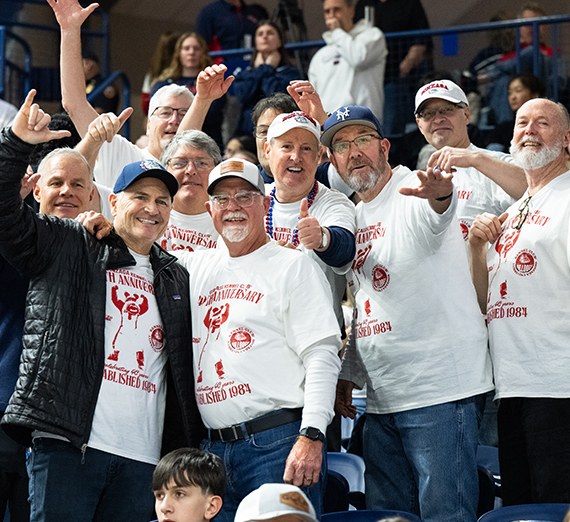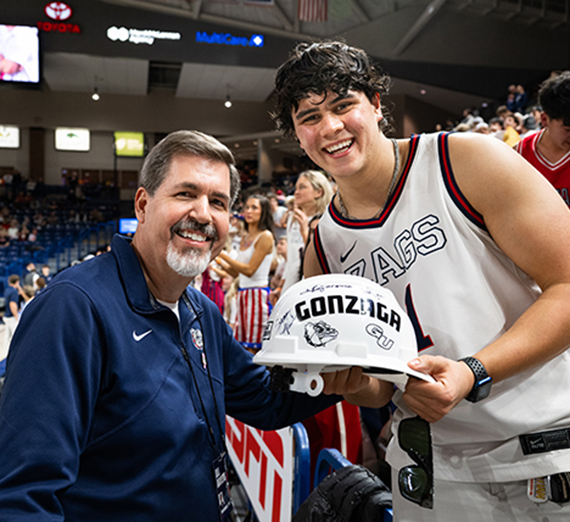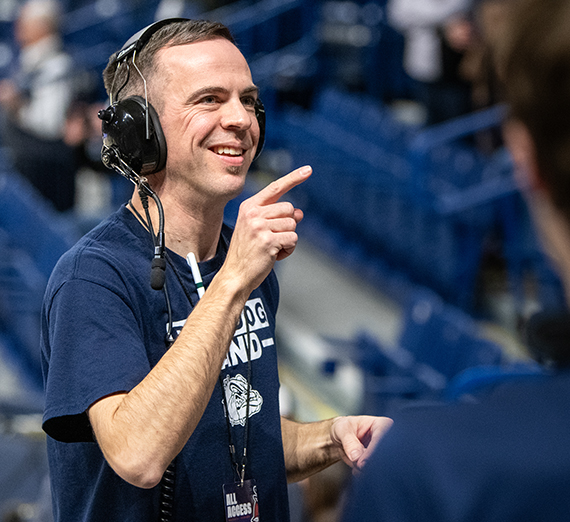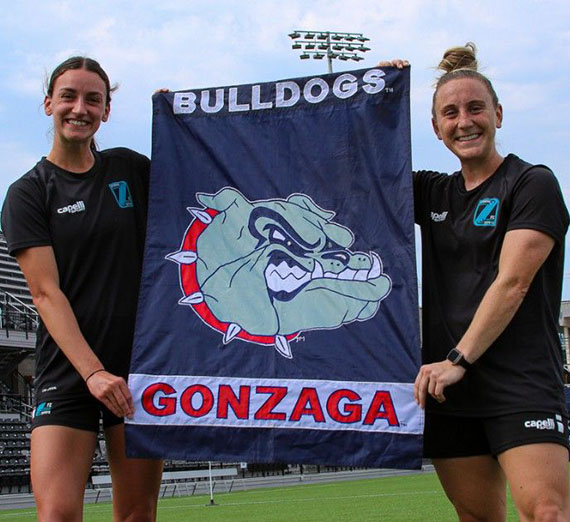Then & Now: Hoops at Gonzaga
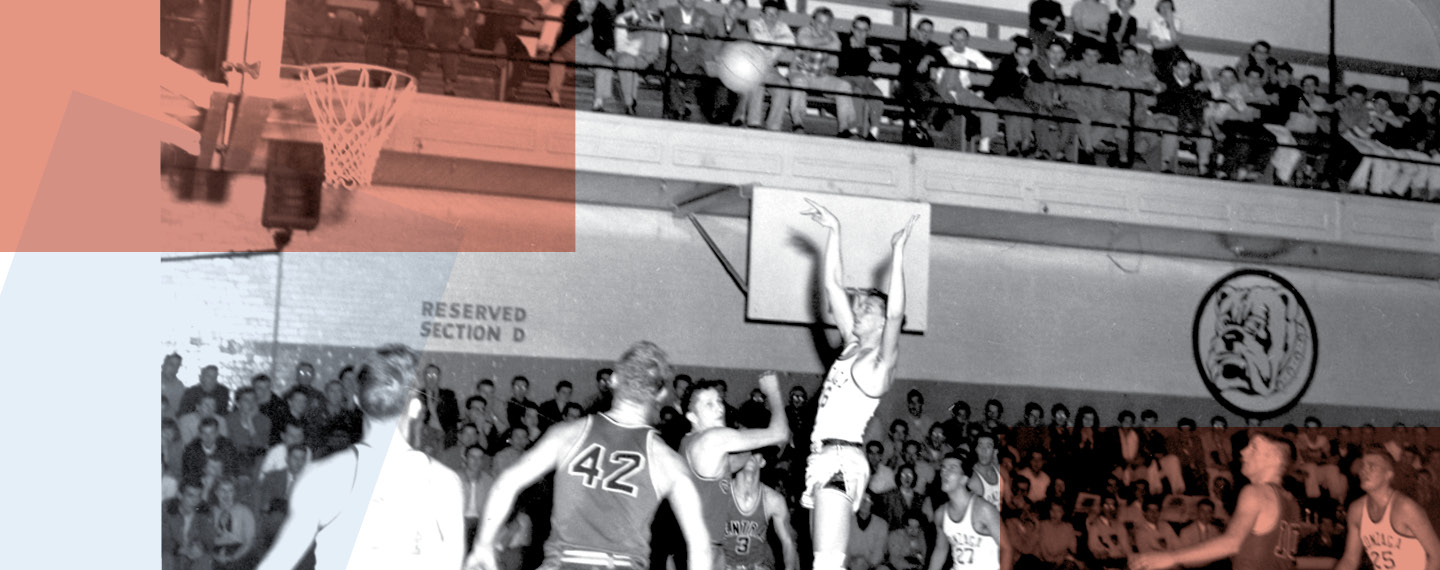
Then & Now: From Basketballs onto Boone, to the Big Time
[Then & Now is a Gonzaga Magazine feature comparing present-day iconic locations and activities to their original foundings. In the Spring 2022 issue, we take a look at the evolution of basketball courts on the Gonzaga campus.]
We’ve come a long way, baby, from the sweatbox that was the Cave to the boisterous setting that is the Kennel.
“There were high windows that didn’t allow for much light, so it seemed very dark,” recalls Mike Shields (’68), who saw a few games in the former Administration Building gym, where Magnuson Theater now sits. “It was always hot. I remember Frank Burgess telling stories about (Coach) Hank Anderson leaving the front door open to cool the place off. Occasionally, a basketball would fly through the open door, bounce down the steps and roll onto snow-packed Boone Avenue.”
Lore has it that when the starter pistol blasted to begin basketball games in the Cave, a few student pranksters would drop a dead chicken from the rafters. With seating only four or five rows deep on both the main floor and overhanging balcony, it would not have come close to accommodating even the visiting teams’ ticket allotment for home games today in the McCarthey Athletic Center.
Opened in 1905, the gym did not host many games after 1955 when the new Spokane Coliseum opened west on Boone Avenue a couple of miles away.
In 1965, a futuristic-looking $1.1 million, 3,800-seat Kennedy Pavilion opened on the south edge of campus. It played host to top 20 basketball opponents as well as fledging bands early in their rise to fame, like “Len Zefflin,” as a local advertisement called the band that made its mark as Led Zeppelin.
“But I’m going to keep a key to the Cave and go in there once in a while to remind myself how lucky we are now,” Anderson said at the time of the move.
It was named for the country’s first Catholic president, John F. Kennedy, whose brother Sen. Ted Kennedy spoke at its dedication. The student body funded part of it through $10 per-student per-semester fees until $500,000 was raised. The University matched it, and raised an extra $100,000 from benefactors.
By 1987, the building needed renovation and a friend of Gonzaga stepped up and donated $4.5 million to refurbish the gym, build a fieldhouse and enclose those two buildings and the pool with a glass-covered atrium. The Charlotte Y. Martin Centre – she insisted on the French spelling of Centre and a sewing room to accommodate those students who were not sports-inclined – became the rejuvenated home of the Zags, and soon after became known as The Kennel.
Once GU men’s basketball began to catch fire in the mid- 1990s, and trips to the NCAA tournament became an annual celebration, a new playing venue was in order. Chuck Murphy was vice president for finance at the time and oversaw planning for a new facility.
“The big question was how big to build it — 6,000 seats or 8,000,” he said. “Coming from Martin Centre with only several hundred season ticket holders, it seemed a stretch to fill 6,000 seats. Financially, it was a significant increase in cost to go from 6,000 to 8,000 seats, and the seats we would add would not be great seats. So, both financially and from a game-experience standpoint, we settled on 6,000,” which Athletics thought it could fill every game, and has accomplished, Murphy said.
McCarthey Athletic Center opened for the 2004 season and has sold out for every game. Construction on the $25 million facility was possible through the lead gift of alumni Phil, Tom, Maureen and Sarah McCarthey and their families, and many other donors.
Certainly, few college arenas give students such prime seating as McCarthey offers Kennel Club members, who stand the minimum required distance away from the court, giving opponents an earful.
More basketball memories
“I remember the first game in Kennedy Pavilion was against WSU,” Shields said. “I was a sophomore sitting behind two freshmen. One said to the other, ‘I’ve never seen so many people in one place in my life.’ We think it only seated 2,700 but seemed like 5,000 to us.”
He remembers DePaul Coach Ray Meyers and his highly ranked Blue Demons coming into Kennedy Pavilion in 1973, and how nice it was for the victorious Coach Meyers to come to a Zag postgame reception. A most memorable win came in 1981 against a University of San Francisco team whose roster included three future NBA players.
Concerts included Paul Revere and the Raiders, a big draw in the 1960s and early ’70s. Professional boxing matches were rivaled in enthusiasm by an occasional Friday Night Smoker when GU students squared off against boxers from Carroll College while the audience lit up their stogies. All part of the Kennedy heritage.
“When moving into McCarthey, I felt the building was so large that I prayed we would be able to fill it,” Shields recalled. “I had no idea the level of success awaiting us.”
The new Kennel is now considered one of the nation’s premier places to play, as often cited by ESPN and CBS broadcasters, in part because of the team, and in part due to the crowd. Beating No. 5 Texas on Nov. 13 in front of a Kennel Club at its peak ranks among the best wins ever in McCarthey.
Then – full of history, and now – full of fans.
- Alumni
- Alumni
- Gonzaga Magazine

